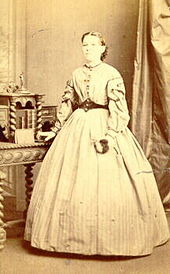Mary Slessor
Mary Mitchell Slessor (born December 2, 1848 in Gilcomston, Aberdeen , † January 13, 1915 in Calabar ) was a Scottish missionary who worked in Nigeria . Her work and strong personality enabled her to be accepted and trusted by the locals as she preached the gospel , helped local children, and stood up for women's rights. It is thanks to her that the Efik stopped killing twins.
youth
Mary Slessor was born the second of five children into a poor working class family. Her father Robert Slessor was originally from Buchan and worked as a shoemaker. In 1859 her family moved to Dundee to find work. Both parents worked at the Baxter Brothers' Mill , and when Mary was eleven she began working part-time in the factory. That is, she spent half the day at school, which was funded by the factory owners, and the other half at work.
The Slessors lived in one of Dundee's slums. Mary's father died of pneumonia; her two brothers also died, leaving Mary, her mother and two sisters behind. By the time Mary was 14, she was already a very talented jute worker. She worked from 6 a.m. to 6 p.m. with an hour break for breakfast and lunch.
Her mother was a dedicated Presbyterian who read every issue of Missionary Record , a United Presbyterian Church magazine , which was published monthly and kept readers informed of activities and needs. Slessor developed an interest in religion and when a mission opened in Quarry Pend she wanted to start teaching there. She was 27 years old when she heard of David Livingstone's death and decided to follow in his footsteps.
Missionary career
Mary Slessor applied to the United Presbyterian Church's Foreign Mission Board. After training in Edinburgh, her journey began on August 5, 1876. About a month later, she arrived in West Africa. Slessor, 28 years old, red hair with light blue eyes, was assigned to the Calabar region where the Efik lived. She was warned about the traditional West African religion of the residents, particularly the superstitions surrounding the birth of twins. For three years Slessor lived in the mission group while she worked for the mission in Old Town and Creek Town. She wanted to go deeper inland from Calabar, but became infected with malaria and was forced to return to Scotland to recover. She left Calabar in 1879. After spending 16 months in Scotland, she was able to return to Africa. Her new job was three miles inland, in Old Town. To save, she learned to cook local food. She sent much of her income to Scotland to live with her mother and sister.
Problems Slessor faced included a lack of education and widespread human sacrifice by village elders who they believed required servants and entourage to advance to the next world.
The birth of twins was seen as a malicious curse. Locals feared that one of the children had an evil spirit as a father, and that the mother was guilty of a great sin. Unable to find out which of the two children had the evil spirit as the father, they often left both babies in the bush. Slessor adopted all the children she found left behind in the bush. Mary once rescued a pair of twins, a boy and a girl, but the boy did not survive. She named the girl Janie and adopted her as a daughter.
After three years, Slessor had to return to Scotland due to health problems. She took Janie with her. For the next three years, Mary looked after her ailing mother and sister, raised Janie, and spoke to many communities about her experiences in Calabar.
After this break, Slessor returned to Calabar, where she rescued hundreds of twins from the bush. She helped heal the sick and stopped the local custom of drinking poison to find out a culprit. As a missionary, she visited other tribes and preached the good news of Jesus Christ . During the third visit to Calabar, news of the death of her mother and sister reached her.
Slessor helped found the Hope Wadell Training Institute in Calabar, which offers professional training for efiks.
Life among the Okoyong and Efik
In August 1888, Mary traveled north to Okoyong, an area where male missionaries had previously been killed. She figured that her teachings, and the fact that she was a woman, would be less scary to the tribes. She lived with the Okoyong and the Efiks for 15 years. She learned the local language, made friends and wherever she went she became known for her pragmatism and humor. Slessor lived a simple life in a traditional house with efiks. Her reputation spread throughout the UK and she became known as the "White Queen of the Okoyong".
In 1892, Mary became Vice Consul in Okoyong, in charge of the local court. In 1905 she became Vice President of the Ikot Obong Local Court.
In 1913 she was given the Order of Saint John . She suffered from health problems but stayed in Calabar, where she died on January 13, 1915.
Web links
- JH Proctor: Serving God and the Empire. Mary Slessor in South-Eastern Nigeria, 1876–1915. In: Journal of Religion in Africa. 30, No. 1, 2000, pp. 45-61. ISSN 1570-0666 , doi: 10.1163 / 157006600X00483
Individual evidence
- ↑ Donna White: Red-hot designers hail Scots missionary for inspiring African style. dailyrecord.co.uk, accessed January 27, 2016 .
| personal data | |
|---|---|
| SURNAME | Slessor, Mary |
| ALTERNATIVE NAMES | Slessor, Mary Mitchell (full name) |
| BRIEF DESCRIPTION | Scottish missionary in Nigeria |
| DATE OF BIRTH | December 2, 1848 |
| PLACE OF BIRTH | Gilcomston, Aberdeen |
| DATE OF DEATH | January 13, 1915 |
| Place of death | Calabar , Nigeria |
